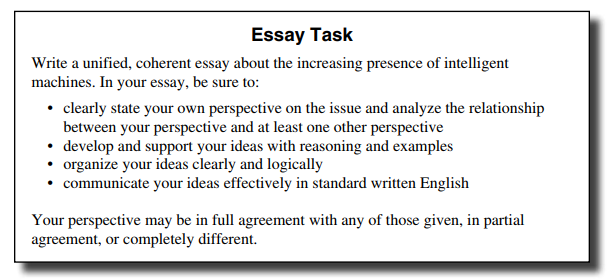5 min read
How to Improve Your Students' Writing Using the ACT Essay Rubric
![]() Nadyja Von Ebers
:
Oct 30, 2017 5:02:05 PM
Nadyja Von Ebers
:
Oct 30, 2017 5:02:05 PM

Because the ACT Writing test is optional, some teachers opt out of preparing students for it. However, many colleges do require the writing test, so you should work it into your curriculum if possible. In addition, teaching the ACT Writing test is a great way to teach essay writing techniques in general, so it’s time well spent in the classroom.

The ACT essay rubric is pretty complex (and its density can be intimidating for students), but teachers can break it down in class and use it effectively to teach the key components of effective essay writing. This complete ACT guide also includes some helpful strategies for taking the ACT Writing test, but here, let’s take a look at how you can incorporate the ACT essay rubric into your class in order to optimize results.
Discuss Prompt Style and Essay Organization
The 40-minute ACT Writing test requires students to read a short prompt introducing them to a compelling and often contentious topic, followed by three differing perspectives on said topic. Students then construct an argumentative essay where they analyze the various perspectives provided, develop their own position on the subject, and delineate the differences between their own stance and the others presented.
This is a lot to juggle and the ACT essay rubric is meaningless if students don’t have a greater context for it. So before doing anything else, acclimate your students to the style of the actual prompt.
This is the format of the essay prompt:

So, the most critical directives to rephrase and stress to students are:
- Take a clear stance on the issue
- Provide support for your stance
- Do the above in a well-organized and well-written manner
In other words, the purpose of the essay is to form an educated argument and to support that argument with evidence.
After making the task at hand crystal clear, students should understand how this type of argumentative essay is organized. This will ensure that the content on the ACT essay rubric actually makes sense to them. The following chart provides a paragraph-by-paragraph breakdown of the requirements for each section of the essay:
|
Introduction |
|
|
Body Paragraph #1 |
|
|
Body Paragraph #2 |
|
|
Conclusion |
|
Discuss Key Terms on the ACT Essay Rubric
The ACT essay rubric is created by and for ACT readers, so some of the language on it may not be entirely accessible to students. Likewise, sometimes educators falsely assume that students understand common academic terms, so it’s a good idea to go over the entire ACT essay rubric with your students to discuss and define any terms they may not feel 100% confident about. It is specifically important to pull terms from the score 6 row of the ACT essay rubric, since this is the level students should ideally be reaching for.
For example (terms taken and adapted from dictionary.com):
Context (n):
The circumstances that form the setting for an event, statement, or idea, and in terms of which it can be fully understood and assessed.
Synonyms: circumstances, situation, conditions, factors, state of affairs, background, scene, setting, scenario
Implication (n):
The conclusion that can be drawn from something, although it is not explicitly stated.
Synonyms: suggestion, insinuation, innuendo, hint, intimation
Bolster (vb):
Support or strengthen; prop up.
Synonyms: strengthen, reinforce, boost, fortify, renew
Analysis (n):
Detailed examination of the elements or structure of something, typically as a basis for discussion or interpretation.
Synonyms: examination, investigation, inspection, study
Tangential (adj):
Relating to or along a tangent.
Tangent (n): a completely different line of thought or action.
Discuss The Meaning of Scorepoints on the ACT Essay Rubric
The current ACT essay rubric consists of four categories of assessment (more on this later), each scored on a scale from 1-6. I suggest discussing the criteria for each score with your students and asking them if they have any questions about the expectation for each.
Score 6:
Criteria: “Responses at this scorepoint demonstrate effective skill in writing an argumentative essay.”
Discuss: The implications of the word “effective.” Note that the expectation for this score is not a “superb” or “perfect” demonstration of the particular skill, but “effective,” meaning that all parts of the scored category are fulfilled and accomplish their purpose.
Score 5:
Criteria: “Responses at this scorepoint demonstrate well-developed skill in writing an argumentative essay.”
Discuss: The implications of “well-developed,” stressing that this means that ideas are not vague or cursory, but expanded upon and supported.
Score 4:
Criteria: “Responses at this scorepoint demonstrate adequate skill in writing an argumentative essay.”
Discuss: The implications of “adequate,” noting that some (probably enough) explanation and evidence is provided, but perhaps without much elaboration. This score is one that meets but does not exceed an expectation; it’s satisfactory.
Score 3:
Criteria: “Responses at this scorepoint demonstrate some developing skill in writing an argumentative essay.”
Discuss: The implications of “some developing skill,” which suggests that the student can partially fulfill the criteria at hand, but not fully. Essay content reads more like a “work in progress” than a fully fleshed out essay.
Score 2:
Criteria: “Responses at this scorepoint demonstrate weak or inconsistent skill in writing an argumentative essay.”
Discuss: The implications of “weak” and “inconsistent,” meaning that the student only fulfills a small portion of the criteria or does so inaccurately.
Score 1:
Criteria: “Responses at this scorepoint demonstrate little or no skill in writing an argumentative essay.”
Discuss: That the essay content did not meet any of the criteria.
Discuss Each Category of the ACT Essay Rubric Individually
It’s beneficial to read and discuss each score for each of the four categories on the ACT essay rubric, meaning you’ll actually examine all 24 boxes on the rubric together as a class. Much like isolating terms and phrases elsewhere on the ACT essay rubric, it’s also a good idea to thoroughly discuss what each category means.
When trying to illustrate for students what various scores for each of these categories look like, use ACT sample essays that provide score explanations for each category.
Ideas and Analysis
This category assesses a student’s overall ability to understand, discuss, and argue about the pervasive topic at hand in the prompt, which provides you an excellent opportunity to review what a topic of main idea is. If a student is unclear on the subject at hand and/or the gist of each perspective presented, there is almost no chance that they will be able to construct a thoughtful response.
Development and Support
This category assesses a student's ability to back up their content and claims, whether they are explaining another person’s perspective or substantiating their own. This is a great opportunity to have students practice identifying and assessing the effectiveness of support in their own practice essays, their peers’ essays, or sample essays.
Organization
This category assesses a student’s ability to format and structure their essays in order to effectively present their content in a meaningful way. This is a great opportunity to work in some lessons about topic sentences, paragraph breaks, and cohesion.
Language Use
This category assesses a student’s ability to use precise word choice, grammar, sentence structure, voice, tone, etc. in order to enhance their argument. Discussing this section of the rubric provides an excellent opportunity to work in mini-lessons on everything from subject-verb agreement to the active vs. passive voice use, to any other conventions your students may need a boost with.
Utilizing the ACT essay rubric in your classroom provides a meaningful opportunity to help prepare students for the ACT Writing test should they need to take it. It’s also an opportunity to review the essential parts of an argumentative essay, so take advantage of that!


